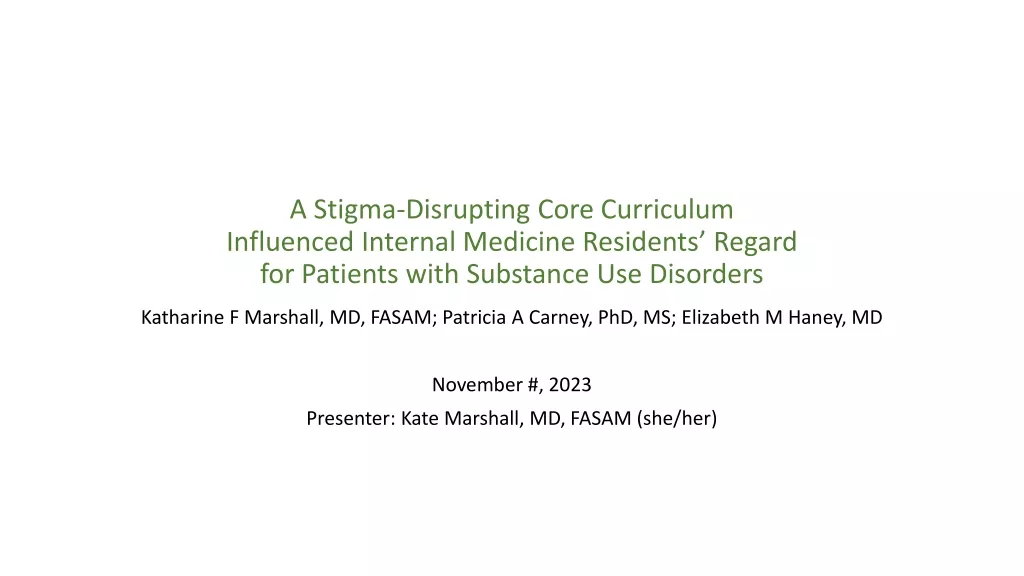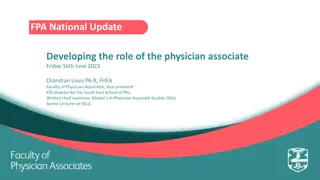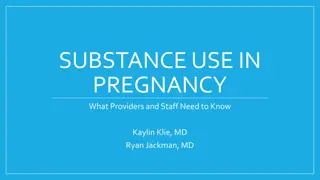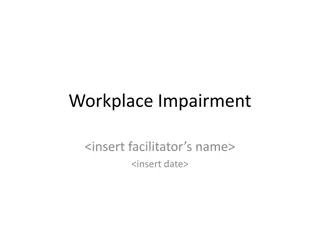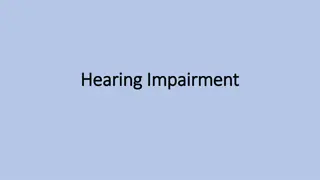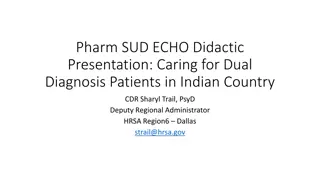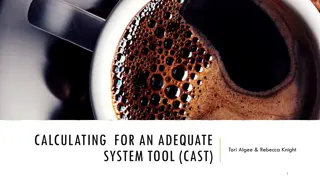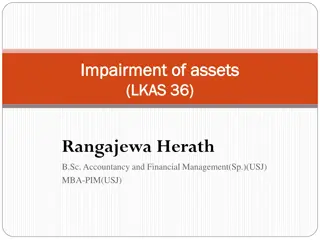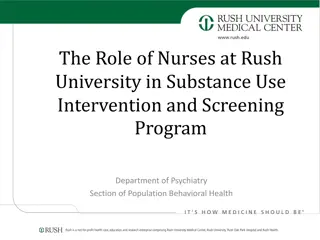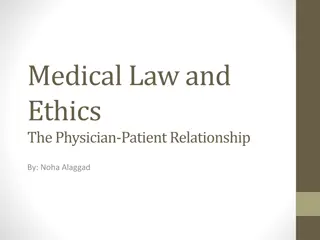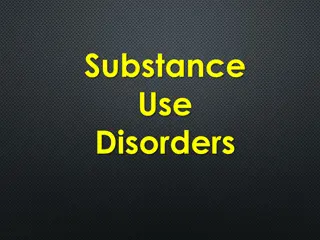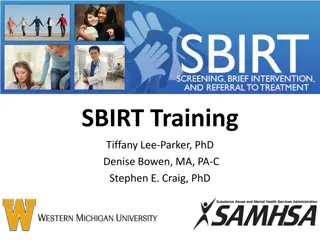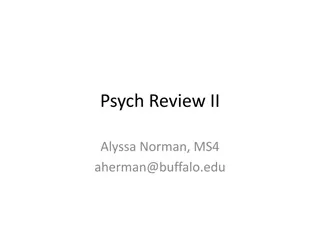Understanding Physician Impairment Due to Substance Use Disorders
Physician impairment due to substance use disorders can severely impact patient safety and clinical outcomes. This article explores the definition, causes, warning signs, assessment, treatment, and return to practice protocols for impaired physicians. Substance abuse in physicians can lead to behavioral dysfunction, medical complications, and co-occurring mental illness, posing risks to both the physician and their patients. The late-stage manifestation of impairment highlights the importance of early intervention and monitoring for improved outcomes.
- Physician Impairment
- Substance Use Disorders
- Addiction in Physicians
- Patient Safety
- Medical Professionals
Download Presentation

Please find below an Image/Link to download the presentation.
The content on the website is provided AS IS for your information and personal use only. It may not be sold, licensed, or shared on other websites without obtaining consent from the author. Download presentation by click this link. If you encounter any issues during the download, it is possible that the publisher has removed the file from their server.
E N D
Presentation Transcript
When the Healer Needs Healing: Impairment in Physicians Elinore F. McCance-Katz, M.D., Ph.D. Professor of Psychiatry University of California San Francisco State Medical Director California Department of Alcohol and Drug Programs
Learning Objectives To gain an understanding of the disease of addiction in physicians including What constitutes hazardous substance use Warning signs Assessment and treatment Return to Practice Monitoring of impaired physicians How does it work? Is it effective?
How Is Impairment in Physicians Defined? A physician who is unable, or potentially unable to practice medicine with reasonable skill and safety to patients because of physical or mental illness, including deterioration through the aging process or loss of motor skills, or excessive use or abuse of drugs including alcohol. AMA The Sick Physician , 1973
Physician Impairment Physician Impairment Refers to situations in which physicians are unable to perform their professional responsibilities adequately because of a variety of health problems: Medical disease Mental Illness Substance abuse
Substance Use Disorders Substance Use Disorders Principal cause of physician impairment Characteristics of addiction: Behavioral dysfunction Medical complications Co-occurring mental illness Loss of control over substance use, overuse, intoxication, withdrawal: Poor occupational functioning and poor clinical outcomes Inability to practice safely Potential harm to patients
Physician Impairment Physician Impairment Not all illness is synonymous with impairment. Impairment of work function, tends to be a late stage of illness phenomenon rather than an early sign. By the time a physician s practice is affected usually there have been adverse consequences to the physician s social life, family life, financial status, and even physical health.
Substance Use What are hazardous use levels? Alcohol >7 drinks per week for women (or > 3 drinks per occasion) and >14 for men (or > 4 drinks per occasion) (NIAAA, 2007). (One drink equals one 12-ounce bottle of beer or wine cooler, one 5-ounce glass of wine, or 1.5 ounces of 80-proof distilled spirits)
Substance Use What are hazardous use levels? Illicit Drugs: Marijuana Stimulants (cocaine, methamphetamine) MDMA Heroin Hallucinogens there are no established safe levels of use; any use could be hazardous depending on individual genetics, drug composition, environment where drug is used
Substance Use Prescription Medications: There are no established safe levels of recreational use Physicians, like others, should have a doctor patient relationship in order to obtain prescription medications No self-prescribing Don t ask colleagues to prescribe to you and don t prescribe to colleagues/other staff
Substance Use Disorders Substance Use Disorders Substance Use Disorders are brain diseases which are: Treatable. Chronic and relapsive. Progressive and may be fatal if untreated.
Prevalence of Disease Prevalence of Disease Substance Use Disorders: Prevalence in physicians probably not different than that of the public at large ~ 10% (SAMHSA, 2009)
Prevalence in Practicing Physicians Prevalence in Practicing Physicians Survey of 9600 physicians: More likely than general population to use alcohol, opiates and benzodiazepines 2% reported alcohol abuse or dependence in last year 11%: unsupervised benzodiazepine use 18%: unsupervised use of opioids 5 times as likely to take sedatives and minor tranquilizers unsupervised Hughes et al. 1992
Prevalence in Resident Physicians Self-report survey data (1,754 U.S. resident physicians): Use of psychoactive substances was generally lower than it was among similar age groups in the general population except for alcohol and benzodiazepines 5% daily drinkers Pediatrics: lowest reported rate of substance abuse Highest rates: ED/psychiatry (cocaine-MJ/BZD-MJ) Surgeons: lower rates of substance abuse except for alcohol Use of benzodiazepines was greater, with self-treatment generally being cited as the reason for such use. Self-prescribing of opioids began in residency concurrent with receiving DEA registration (Hughes et al. 1991)
Prevalence in Resident Physicians: Emergency Medicine 1,580 ED residents responses to anonymous survey with CAGE questions: C: cut back A: annoyed when criticized about drinking G: guilt over drinking E: eye opener Score of 1: evaluate further for hazardous alcohol use; >2 indicative of alcohol use disorder Alcoholism in 4.9% (2 or more CAGE questions positive) 16.9%: score > 2 lifetime 12.2% suspected another resident of having substance problem (McNamara et al. 1994)
Prevalence in Resident Physicians: Anesthesia Anesthesiology residents: lower lifetime use of marijuana and cocaine than among other groups of residents Possible self-selection for drug use and specialty (Lutsky et al. 1991) Survey of department chairs of the 133 US anesthesiology training programs: Known rates of drug abuse: Faculty 1%; Residents: 1.6% Most widely abused drug: Fentanyl Interventions: increased hours of substance abuse training; tighter controls on controlled substance inventories (dispensing/disposing) (Booth et al. 2002 ) Anesthesia: most deaths from drug abuse occur in first 5 years out of medical school suicide rate increases with age (Alexander et al. 2000)
Prevalence of Impairing Prevalence of Impairing Illnesses in Medical Students Illnesses in Medical Students 12% estimated to suffer depression in the first two years of school. Women medical students have same suicide rate as male students, and 3-4 X age- matched controls. Rates of illicit drug, prescription narcotic and alcohol abuse: 7 18% Survey of 2046 students: 1.6% responded that they currently needed help for substance abuse. Balwin et al. 1991, Center et al. 2003
Prevalence in Physicians Rates of substance abuse thought to be related to use in adolescence Most data is quite old few resources are invested in this topic Rates of substance abuse and addiction are increasing in youth in U.S. general population Therefore, it is quite possible that rate in physicians are higher particularly for controlled substances (McBeth and Ankel, 2008)
Rates of Prescription Narcotic Abuse: Youth in the United States Prescription Narcotic Abuse Prevalence: 12th graders: 1992: 3.3% 179% increase over 15 years OxyContin 8th 1.8% 10th 3.9% 12th 5.2% 2007: 9.2% Vicodin 8th 2.7% 10th 7.2% 12th 9.6% Source: Monitoring the Future, 2007. These statistics are likely to be important in thinking about vulnerability to substance abuse in physicians.
Can Impairment Be Predicted? Can Impairment Be Predicted? Physicians disciplined by their regulatory Boards were 3X as likely as to have demonstrated unprofessional behavior in medical school. The largest number of disciplinary actions were related to the use of alcohol and drugs. Papadikis et al. 2005
Co-Occurring Mental Illness Substance use disorders often co-occur with depression. In physicians, depression is common and has been reported to occur at a lifetime prevalence rate of 12.8% in men and 19.5% in women (Center et al, 2003, Ford et al. 1998).
Co-Occurring Mental Illness Suicide is a risk: Suicide prevalence (relative risk compared to the general population) for male physicians is 1.1- 3.4 and 2.5-5.7 for female physicians (Frank and Dingle, 1999). Due to the physician s greater knowledge of lethal drugs and access, rates of completed suicides are higher in the physician population.
What Prevents Physicians From What Prevents Physicians From Getting Help? Getting Help? Ignorance about disease Fear of the stigma attached to diseases such as depression and chemical dependence Self-diagnosis and curbside consults Concern about confidentiality Time Constraints
What Prevents Physicians From What Prevents Physicians From Getting Help? Getting Help? Fear of jeopardizing one s career Culture of medical education and medicine that rewards individuals who are self-reliant, high achievers, competitive leads to isolation and the notion that good doctors have few needs Character traits of physicians to be self- sacrificing at the expense of their own health and needs Family and colleagues participating in conspiracy of silence
Identifying the Impaired Physician Identifying the Impaired Physician High risk conditions: Family history Access Domestic breakdown, stress at home Unusual stress at work (malpractice suit) Self-diagnosing and self-prescribing Poor self-care
Identifying the Impaired Physician Identifying the Impaired Physician It is often difficult to identify chemical dependence and substance abuse among our colleagues. Signs are subtle and attributed to other problems. Changes in behavior are often gradual and overlooked on a day-to-day basis. Often, the workplace is the last place to be affected by chemical dependence.
What are Some of the Indicators of What are Some of the Indicators of Substance Abuse or Addiction? Substance Abuse or Addiction? Alcohol on breath DUI Tremors Often late Mondays Missing work frequently; calling in sick Mood Swings
What are Some of the Indicators of What are Some of the Indicators of Substance Abuse or Addiction? Substance Abuse or Addiction? Drowsy or sleeping at work Slurred speech on phone Inappropriate orders Inconsistent work performance Deteriorating physical appearance; weight loss Missing medications Unusual prescribing practices
What is Substance Abuse? One or more in a 12 month period: Recurrent use resulting in failure to fulfill major role obligation: work, school, home Recurrent use in hazardous situations (e.g.: driving under the influence) Substance-related legal problems Continued use despite recurrent social or interpersonal problems
What is Substance Dependence (Addiction)? Three or more of these seven criteria in a 12-month period: 1. Tolerance (need for increasing amounts to get expected effects) 2. Withdrawal(agroup of symptoms that occurs upon the abrupt discontinuation of or a decrease in dosage of medications, recreational drugs, and/or alcohol which are usually the opposite of what effects the drug itself produces) 3. More or longer consumption than intended
What is Substance Dependence (Addiction)? 4. Cannot cut down or control use 5. A great deal of time getting, using, recovering from substance 6. Activities given up or reduced 7. Use despite knowledge of health problem Diagnostic and Statistical Manual of Mental Disorders, Text Revision (DSM IV-TR)
What If Impairment Occurs? Impaired physicians are removed from practice and usually enter treatment Intervention is undertaken to assist with getting practitioner to full medical/psychiatric assessment/treatment Denial is universal characteristic of disease and very difficult to overcome even in the face of overwhelming consequences.
Assessment Assessment Physicians generally receive multi-day assessment: Medical evaluation Psychiatric evaluation Substance Abuse evaluation Neuropsychological evaluation Collateral information Family Therapy evaluation Assessment team discusses findings and determines diagnosis and treatment recommendations
Treatment Treatment Should occur at facilities that specialize in the treatment of health care professionals Physicians, pharmacists, dentists, nurse anesthetists more likely to receive long term residential care (30-90 days)
Treatment Treatment Inpatient/Residential Treatment Components: Detoxification Med/Psych evaluation Individual/Group therapy Alcoholics Anonymous/Narcotics Anonymous introduction Family Therapy Initiation of pharmacotherapy
Treatment Outpatient Treatment Components (after completion of residential): Group therapy usually weekly for 2-3 years Continued AA/NA Family therapy as needed Identification of support system for practitioner Continued pharmacotherapy (as indicated) Monitoring to include urine screening
Pharmacotherapy Alcohol FDA approved medications Naltrexone (an opioid antagonist thought to be helpful with reducing alcohol craving) Disulfiram (blocks alcohol metabolism with increases in acetaldehyde which cause a noxious reaction if alcohol is consumed Acamprosate (thought to modulate GABA and glutamate neurotransmission to help reduce craving)
Pharmacotherapy May be helpful; particularly for physicians who will have heavy consequences for relapse Physicians may be offered disulfiram over other alcohol pharmacotherapies because it can help to completely stop use which is thought to be the best option for healthcare practitioners with alcohol dependence Barth, 2010, Garbutt, 2009
Pharmacotherapy Medications for Opioid Dependence Methadone Buprenorphine Medical Boards (state regulatory agencies) do not usually support the use of opioid agonists in addicted physicians Naltrexone: an opioid antagonist that blocks the positive effects of opioids; often used to treat physicians with opioid addiction McCance-Katz, 2005
Re Re- -Entry to Practice: Role of Entry to Practice: Role of Physician Health Programs Physician Health Programs Most states support programs that assist with physician health through a program of monitoring Physicians voluntarily enter into a physician health program that will provide monitoring services to assist with ongoing treatment and assure abstinence Physicians sign a contract which will stipulate whether and under what conditions a physician may practice, continuing treatment, urine toxicology screening, work site monitoring, self-help groups
Re Re- -Entry to Practice: Role of Entry to Practice: Role of Physician Health Programs Physician Health Programs Initial rehabilitation process complete Participation in continuing treatment Abstinence has been initiated and maintained for a period of time
Relapse Risks Major opioid (e.g.: injectable drugs such as dilaudid, fentanyl) use + Co-occurring mental disorder (Risk Ratio: 5.79) Family history of substance use disorder (Risk ratio: 2.29) Having all 3 risk factors (Risk Ratio: 13.25) Domino et al. 2005
Medicolegal Issues Legal aspects of physician impairment handled primarily at state level State licensing organizations can withdraw a license from a practitioner deemed to be impaired/incompetent Primary goal of licensing boards is to protect public from unqualified health care practitioners
Medicolegal Issues History of substance abuse is queried on staff applications and renewals Employer based drug testing increasing; positive test will be followed up with an assessment For physicians: National Practitioner Data Bank is repository for actions of state licensing boards, hospital medical staff actions. state medical societies and malpractice claims (voluntary entrance to substance abuse treatment is not reportable)
Are Physician Health Programs Effective? Physician Health Programs (treatment/monitoring/sanctions) in the U.S. are being evaluated to determine their effectiveness. Physicians with substance use disorders are often referred to such programs. 5-year follow up study (n=804) McLellan et al. 2008 19% of impaired physicians failed the monitoring program (usually by relapse early in treatment) 81% successfully completed treatment and returned to practice under monitoring
Is Treatment an Effective Means of Resolving Substance Abuse in Physicians? Alcohol or drug use was detected by urine drug screening in 19% of the remaining physicians over 5 years, 26% had multiple relapses. Relapsers were removed from practice. At 5 years: 78.7% of program participants were working as physicians 10.8% had their licenses revoked 3.5% retired 3.7% died 3.2 % unknown
How to Get Help Local Wellness Committees State Medical Societies State branches of American Medical Association (e.g.: CMA) Federation of State Physician Health Programs (www.fsphp.org) can provide information on programs available by state
References AMA Council on Mental Health. The sick physician: Impairment by psychiatric disorders, including alcoholism and drug dependence. JAMA 1973;223:684-687. Alexander BH, Checkoway H, Nagahama SL, Domino K: Cause specific mortality risks of anesthesiologist. Anesthesiology 2000; 93: 922-930. Balwin DC, Hughes PH, Conard sE, Storr CL, Sheehan DV: Substance abuse among senior medical students. JAMA 265: 2074-2078, 1991. Barth KS, Malcolm RJ. Disulfiram: an old therapeutic with new applications. CNS Neurol Disord Drug Targets 2010;9:5-12 Booth JV, Grossman D, Moore J: Substance abuse among physicians: a survey of academic anesthesiology programs. Anesth Analg. 2002; 95(4):1024-30 Carrington R, Fiellin D, O Connor PG: Hazardous and Harmful Alcohol Consumption in Primary Care Arch Inter Med. 1999;159:1681-1689. Center C, et al. Confronting depression and suicide in physicians. A consensus statement. JAMA 289: 3161-3166, 2003.
References Domino KB, Hornbein TF, Polissar NL, Renner G, Johnson J, Alberti S, Hankes L: Risk factors for relapse in health care professionals with substance use disorders. JAMA 293: 1453-1460, 2005. Ford DE, Mead LA, Chang PP, Cooper-Patrick L, Wang NY, Klag MJ. Depression is a risk factor for coronary artery disease in men: the precursors study. Arch Intern Med. 1998;158:1422-1426. Frank E, Dingle AD. Self-reported depression and suicide attempts among US women physicians. Am J Psychiatry. 1999;156:1887-1894. Fuller RD, Willford WO, Lee KK, Derman R: Veterans Administration cooperative study of disulfiram in the treatment of alcoholism: study design and methodological considerations. Control Clin Trials. 1984 Sep;5(3):263-73
References Garbutt JC. The state of pharmacotherapy for the treatment of alcohol dependence. J Subst Abuse Treat 2009;36:S15-23; quiz S24-5 Hughes PH, Brandenburg N, Baldwin DC, Storr CL, Williams KM, Anthony JC, Sheehan DV: Prevalence of substance use among US physicians. JAMA 267: 2333-2339, 1992. Hughes PH, Conard SE, Baldwin DC, Storr CL, Sheehan DV. Resident physician substance use in the United States. JAMA 1991;265:2069-2073. Lutsky I, Abram SE, Jacobson GR, Hopwood M, Kampine JP. Substance abuse by anesthesiology residents. Acad Med 1991;66:164-166. McBeth BD, Ankel FK: Don t ask, don t tell: Substance use by resident physicians. Acad Emer Med 2008; 13: 893-895. McNamara RM, Sanders AB, Ling L, Witzke DB,Bangs KA. Substance use and alcohol abuse in emergency medicine training programs, by resident report. Acad Emerg Med. 1994; 1:47 53.
References McCance-Katz EF, Kosten TR: Psychopharmacological treatments. In Clinical Textbook of Addictive Disorders (third edition), S. Miller and R. Frances (eds.) Guilford Press, New York, NY, pp. 588-614, 2005. McLellan AT, Skipper GS: Campbell M, Dupont RL: Five year outcomes in a cohort study of physicians treated for substance use disorders in the United States. BMJ 2008 337:a2038. O Malley SS, Jaffe AJ, Chang G, Schottenfeld RS, Meyer RE, Rounsaville B: Naltrexone and coping skills therapy for alcohol dependence. Arch Gen Psychiatry 49: 881-887, 1992. Papadikis MA, Teherani A, Banach MA, Knettler TR, Rattner SL, Stern DT, Veloski JJ, Hodgson CS: Disciplinary action by medical boards and prior behavior in medical school. N Engl J Med. 2005 Dec 22;353(25):2673-82 SAMHSA, National Survey on Drug Use and Health, 2009 Wischmeyer PE, Johnson BR, Wilson JE, Dingman C, Bachman HM, Roller E, Tran ZV, Henthorn TK: A survey of propofol abuse in anesthesia programs. Anesth Analg. 2007; 105(4):1066-71


